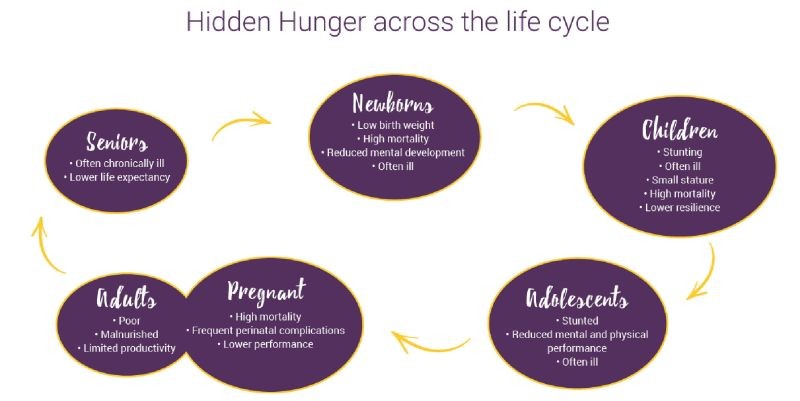
Biofortification or biological fortifications refer to nutritionally superior food crops with improved bioavailability to the human population that are developed and grown using modern biotechnology techniques, conventional plant breeding, and agronomic practices. Biofortification is a promising, cost-effective, and sustainable technique of delivering micronutrients to a population that has limited access to a variety of diets and other micronutrient interventions.
Hidden Hunger
Deficiencies in micronutrients such as zinc, iron and vitamin - A can cause intense and severe damage to the body like blindness, growth stunting, mental retardation, learning disabilities, low work capacity, and even premature death. The effects of hidden hunger are sensitive from conception to the age of two years. Micronutrient deficiencies are especially damaging to women. Five hundred million women aged 15 to 49, at the peak of their productive years, are anemic due to iron deficiency. This condition decreases their productivity, economic potential, and affects their reproductive health conditions. The biofortified food crops, especially cereals, legumes, vegetables, and fruits, are providing adequate levels of micronutrients to targeted populations. Besides the challenges, biofortified crops hold a bright future to address the malnutrition challenge. Today we are imagining reaching a billion people with biofortified foods by the year 2030.
So far, our agricultural system has not been designed to support human health instead, it only focuses on increasing grain yield and crop productivity. This approach has resulted in a rapid rise in micronutrient deficiency in food grains. Agriculture is undergoing a change from producing more quantity of food crops to producing nutrient-rich food crops in sufficient quantities. This will help in fighting “hidden hunger” or “micronutrient malnutrition” especially in poor and developing countries, where diets are dominated by micronutrient poor staple food crops.
Advantages of biofortified crops
• It can be introduced quickly and can produce nutritional benefits for the population in a short period of time.
• Fortification provides micronutrients in amounts that are appropriate. Hence, it is safer than supplements. When properly regulated, fortification carries a minimal risk of chronic toxicity.
• Fortification of widely distributed and consumed foods has the potential to improve the nutritional status of a large population, covering both poor and wealthy.
• Fortification does not require changes in existing food patterns, nor individual compliance which are very difficult to achieve.
• It is feasible to fortify foods with several micronutrients simultaneously, to treat multiple micronutrient deficiencies that often coexist in a population that has a poor diet.
• Fortification is often more cost-effective than other strategies, especially in case the technology already exists and an appropriate food distribution system is already in place as in India.
Limitations of biofortified crops
• A specific fortified foodstuff might not be consumed by all members of a target population.
• Infants and young children, who consume relatively small amounts of food, are less likely to fulfill their recommended micronutrients from universally fortified staples alone.
• Fortified foods often fail to reach the poorest segments of the general population due to their low purchasing power and an underdeveloped distribution channel. Availability, access and consumption of adequate quantities and a variety of micro nutrient-rich food, such as animal food, fruits and vegetables, is limited.
• Very low-income population groups are known to have co-existing multiple micronutrient deficiencies. Although multiple micronutrient fortification is technically possible, the poor will be unable to obtain recommended intakes of all micronutrients from fortified foods alone.
• Nature of the food vehicle or the fortificant, sometimes limit the amount of fortificantion. For example, some iron fortificants change the colour and flavour of many foods, and can cause the destruction of fortificant vitamin A and iodine.
• Although it is cost-effective than other strategies, there are however significant costs associated with the food fortification process, which might limit the implementation and effectiveness of food fortification programmes in developing country like India.
Conclusion
It is established that biofortification is a promising, cost-effective, agricultural strategy for improving the nutritional status of malnourished populations throughout the world. Biofortification approach is based on crop breeding, targeted genetic manipulation, and/or the application of mineral fertilizers hold enormous potential for addressing mineral malnutrition in humans. To attain this, collaboration between plant breeders, nutrition scientists, genetic engineers, and molecular biologists is necessary. Traditional breeding approaches are finding widespread and easy acceptance and have been used to improve the nutritional qualities of food. The generation of biofortified food crops with improved nutrient contents such as increase in iron, zinc, Se, and pro-vitamin A content are providing sufficient levels of these and other such micronutrients that are commonly deficient in the diets. International initiatives, such as the HarvestPlus program and national initiatives, are acting as pillars to accomplish these targets. These efforts have delivered crops with the potential to increase both the amounts and bioavailability of essential mineral elements in human diets, especially in staple cereal crops like wheat, maize, cassava, beans, sweet potatoes, and millets.
Sources:
1. https://www.harvestplus.org.
2. https://www.who.int/elena/titles.
3. https://www.ncbi.nlm.nih.gov.
Article contributed by Dr Hannah Krujia Asangla, ACTO – Agronomy & Vesalu Khape, YP II, KVK Phek




